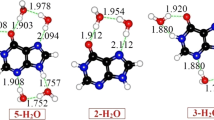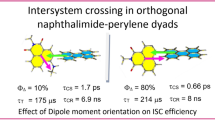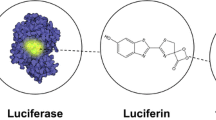Abstract
The activation or functionalization of the saturated C-H is an extremely active field at present. We have explored the triplet state thioxanthone in reactivity of the hydrogen transfer reaction between donors and acceptors. In our works, two donors with quasi-inert sp3 C-H of skipped diene (3,6-nonadiene) and cyclic acetals (benzodioxole) reacted with type II photoinitiators (triplet state of thioxanthone series, TXs) as acceptors are investigated. The excited energies of TXs were obtained by time-dependent density functional theory (TD-DFT). TXs show obvious photosensibility based on their low reorganization energies (< 60 kcal mol−1). The isoentropy reactions had linear geometries of transition state (TS). The distortion/interaction model was used to probe the existence of interaction between acceptors and donors in saddle point. The distortion energy and activation barrier of benzodioxole are much higher than those of the corresponding 3,6-nonadiene. The lower bond dissociation energy noticeably affect the transition state. The reaction of triplet state of TXs with skipped dienes were found to have an anomalous low tunneling factors by using Wigner correction and early transition state by using the bond-energy–bond-order method. The triplet state of TXs photoinitiator can induced the hydrogen abstraction from saturated cyclic acetals and the skipped alkadienes. The hydrogen abstraction experiment are confirmed by UV and real-time FTIR.






Similar content being viewed by others
References
Davies HML (2016) Recent advances in catalytic enantioselective intermolecular C-H functionalization. Angew Chem Int Ed 45(39):6422–6425. https://doi.org/10.1002/anie.200601814
Davies HML, James RM (2008) Catalytic C–H functionalization by metal carbenoid and nitrenoid insertion. Nature 451(7177):417–424. https://doi.org/10.1038/nature06485
Jay AL, John EB (2002) Understanding and exploiting C–H bond activation. Nature 417(6888):507–514. https://doi.org/10.1038/417507a
Zhou H, Huang YG, Zhang Y, Song DD, Huang H, Zhong C, Ye GD (2016) Hydrogen abstraction of carbon/phosphorus-containing radicals in photoassisted polymerization. RSC Adv 6(73):68952–68959. https://doi.org/10.1039/C6RA00156D
Ye GD, Courtecuisse F, Allonas X, Ley C, Croutxe-Barghorn C, Raja P, Taylor P, Bescond G (2012) Photoassisted oxypolymerization of alkyd resins: kinetics and mechanisms. Prog Org Coat 73(4):366–373. https://doi.org/10.1016/j.porgcoat.2011.03.015
Zhou H, Song DD, Zhong C, Ye GD (2016) Theoretical and experimental study of light-assisted polymerization by multimechanism action. Sci Rep UK 6(1):38473. https://doi.org/10.1038/srep38473
Aydemir M, Baysal A, Özkar S, Yıldırım LT (2011) Ruthenium complexes of aminophosphine ligands and their use as pre-catalysts in the transfer hydrogenation of aromatic ketones: X-ray crystal structure of thiophene-2-(N-diphenylthiophosphino)methylamine. Polyhedron 30(5):796–804. https://doi.org/10.1016/j.poly.2010.12.011
Irmouli Y, George B, Merlin A (2009) Study of the polymerization of acrylic resins by photocalorimetry: interactions between UV initiators and absorbers. J Therm Anal Calorim 96(3):911–916. https://doi.org/10.1007/s10973-009-0061-0
Tehfe MA, Dumur F, Graff B, Morlet-Savary F, Fouassier JP, Gigmes D, Lalevée J (2012) Trifunctional photoinitiators based on a triazine skeleton for visible light source and UV LED induced polymerizations. Macromolecules 45(21):8639–8647. https://doi.org/10.1021/ma301931p
Warzeska ST, Zonneveld M, Van Gorkum R, Muizebelt WJ, Bouwman E, Reedijk J (2002) The influence of bipyridine on the drying of alkyd paints: a model study. Prog Org Coat 44(3):243–248. https://doi.org/10.1016/S0300-9440(02)00057-7
Frisch MJ, Trucks GW, Schlegel HB, Scuseria GE, Robb MA (2016) Gaussian 16. Gaussian Inc., Wallingford
Sébastien C, Frédéric B, Eric H (2013) KiSThelP: a program to predict thermodynamic properties and rate constants from quantum chemistry results. J Comput Chem 35(1):82–93. https://doi.org/10.1002/jcc.23470
Tian L, Feiwu C (2012) Multiwfn: a multifunctional wavefunction analyzer. J Comput Chem 33(5):580–592. https://doi.org/10.1002/jcc.22885
Stratmann RE, Scuseria GE, Frisch MJJ (1998) An efficient implementation of time-dependent density-functional theory for the calculation of excitation energies of large molecules. J Chem Phys 109(19):8281–8224. https://doi.org/10.1063/1.477483
Jacquemin D, Perpète EA, Ciofini I, Adamo C (2009) Accurate simulation of optical properties in dyes. Acc Chem Res 42(2):326–334. https://doi.org/10.1021/ar800163d
Peach MJG, Benfield P, Helgaker T, Tozer DJ (2008) Excitation energies in density functional theory: an evaluation and a diagnostic test. J Chem Phys 128(4):044118. https://doi.org/10.1063/1.2831900
Jacquemin D, Planchat A, Adamo C, Mennucci B (2012) TD-DFT assessment of Functionals for optical 0–0 transitions in solvated dyes. J Chem Theory Comput 8(7):2359–2372. https://doi.org/10.1021/ct300326f
Truhlar DG, Garrett BC, Klippenstein SJ (1996) Current status of Transition-State theory. J Phys Chem 100(31):12771–12800. https://doi.org/10.1021/jp953748q
Lee CT, Yang WT, Parr RG (1988) Development of the Colle-Salvetti correlation-energy formula into a functional of the Electron-density. Phys Rev B 37(2):785–789. https://doi.org/10.1103/PhysRevB.37.785
Jacquemin D, Perpète EA, Ciofini I, Adamo C (2010) Assessment of Functionals for TD-DFT calculations of singlet−triplet transitions. J Chem Theory Comput 6(5):1532–1537. https://doi.org/10.1021/ct100005d
Huang H, Liu HH, Zhou H, Liang ZL, Song DD, Zhang Y, Huang WQ, Zhao XT, Wu B, Ye GD, Huang YG (2019) Drug-release system of microchannel transport used in minimally invasive surgery for hemostasis. Drug Des Devel Ther 13:881–896. https://doi.org/10.2147/DDDT.S180842
Blowers P, Masel RI (1998) Conservation of bond order during radical substitution reactions: implications for the BEBO model. J Phys Chem A 102(48):9957–9964. https://doi.org/10.1021/jp9829243
Bickelhaupt FM, Houk KN (2017) Das distortion/interaction-activation-strain-Modell zur analyse von Reaktionsgeschwindigkeiten. Angew Chem 129(34):10204–10221. https://doi.org/10.1002/ange.201701486
Wolters LP, Bickelhaupt FM (2015) The activation strain model and molecular orbital theory. Wiley Interdiscip Rev Comput Mol Sci 5(4):324–343. https://doi.org/10.1002/wcms.1221
Liang ZL, Liu HH, Su NJ, Song DD, Zhang Y, Huang H, Zheng JQ, Zhong C, Ye GD (2018) Study of the deformation/interaction model: how interactions increase the reaction barrier. J Chem NY 2018:1–8. https://doi.org/10.1155/2018/3106297
Song DD, Wu B, Huang BY, Zhang Y, Huang H, Liang ZL, Ke ZF, Ye GD (2016) Comparative analysis of linear and non-linear transition state of hydrogen transfer reaction between benzoyl type radicals with skipped alkadienes. Comput Theor Chem 1081:25–29. https://doi.org/10.1016/j.comptc.2016.01.021
Funding
The authors’ works are supported by the National Natural Science Foundation of China (Grant No. 21274032), the Natural Science Foundation of Guangdong Province (Grant No. 2014A030313500), and The Undergraduate Innovation and Entrepreneurship Training Program of Guangdong Province (Grant Numbers: 201810570083). This work was also funded by the Training Program for Academic Backbone in High-Level University (Grant Numbers: B185004195). The corresponding author, Guodong Ye, would like to thank the above funding sources. Xiaotian Zhao , Wanqiu Huang , Dandan Song are co-first authors
Author information
Authors and Affiliations
Corresponding author
Additional information
Publisher’s note
Springer Nature remains neutral with regard to jurisdictional claims in published maps and institutional affiliations.
Electronic supplementary material
ESM 1
(DOCX 20 kb)
Rights and permissions
About this article
Cite this article
Zhao, X., Huang, W., Song, D. et al. The hydrogen transfer reaction between the substance of triplet state thioxanthone and alkane with sp3 hybridization hydrogen. J Mol Model 26, 56 (2020). https://doi.org/10.1007/s00894-020-4300-4
Received:
Accepted:
Published:
DOI: https://doi.org/10.1007/s00894-020-4300-4




